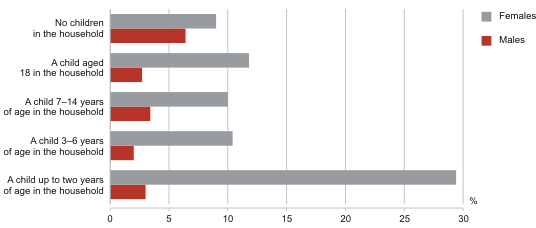The biggest share of part-time employees can be found among women with children aged up to 2 years
In Estonia part-time work is not widely practised. In 2010, 10% of women in the prime working age (aged 25–49) and only 4% of men at the same age worked part-time. In 2010, in the European Union (EU), 29% of women in the prime working age worked part-time. Part-time work was most common among working women in the Netherlands (72%), Switzerland (63%) and Germany (46%). Compared to women in Estonia, the number of women in the prime working age and working part-time was even smaller in Greece (9%), Lithuania (8%), Slovakia (4%) and Bulgaria (2%). Men working part-time were rare also elsewhere in the EU. In 2010, in the EU only 6% of men in the prime working age (aged 25–49 worked part-time, only in the Netherlands the corresponding indicator was above 10%.
Besides gender, the presence of children in the household also affects working part-time. The number of men working part-time was lower and that of women was higher when there were children in the household. While the share of men who were working part-time was not essentially influenced by the age of children, women with children aged up to two years clearly stood out. Nearly one third of working women with so small children worked part-time. The share of women with older children and working part-time was similar to that of working women aged 25–49 in total.
The need to take care of children was reported as the reason for working part-time by more than a half of the women working part-time who had children up to two years of age. For others the main reasons were shortage of orders or work or inability to find full-time work.
Part-time employees are defined as the persons employed who work less than 35 hours per week, except the occupations where the law prescribes short-time working. Estimations are based on the Estonian Labour Force Survey.
A more thorough overview can be found in the publication of Statistics Estonia “Man’s home is the world, woman’s world is her world“(/uudised/49433).The presentation of the publication for the journalists will take place today, on 31 October at 12.00 in the Information Centre of Statistics Estonia (Tallinn, 15 Endla St, ground floor).
Part time working among persons aged 25–49 by gender and age of children, 2010
